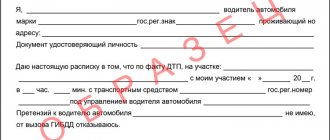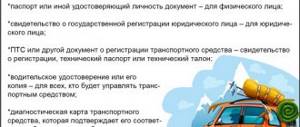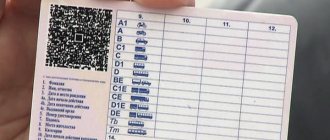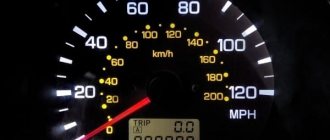You have chosen a car, checked its condition and agreed on a price with the seller. All that remains is to conclude a purchase and sale agreement, transfer the money and go to the traffic police to register the car in your name. Or do you need to pay only after registration? When to transfer money when buying a car?
There are no state-regulated rules. Pay whenever you want, or rather, as agreed with the seller. We talk about the most popular options for transferring money when buying a car.
Payment after registration with the traffic police and prepayment
Don't want to take risks? We understand. Therefore, we suggest agreeing with the seller on the following. After concluding the contract, you make an advance payment, and transfer the entire amount only after checking the car at the traffic police. You will have to go to the department together.
To prevent the seller from being nervous, make a note in the contract that ownership of the vehicle passes to you only after the entire amount is transferred. To avoid stress yourself, ask the seller to write a receipt for the prepayment received. You can do without it altogether, depending on what you agree on.
Pros: you pay only after you make sure that there are no problems with the car. The seller will personally make sure that the car is no longer on him, taxes and possible fines for violating traffic rules will not come to him.
Cons: not every seller will agree to such conditions. By law, he is not required to go to the traffic police, and the prospect of spending a couple of hours in a government-owned house is unlikely to tempt him.
Also read: How to register a used car with the traffic police
Pros and cons of settlements between buyer and seller for a car
Buying a car in cash entails the most risks. In this case, it is difficult to ensure the security of payments, especially if the buyer and seller do not know each other and saw each other for the first time when drawing up the contract and signing the receipt. Below we will describe the main nuances of settlements using all the methods that the buyer and seller can choose.
Cash
Paying in cash is the easiest and fastest way. But the cost of even a used car is a significant amount, which entails serious risks for the seller and the buyer:
- if the receipt is executed incorrectly or this document is not drawn up, problems may arise when proving payment for the car (for example, in the absence of a receipt, the seller can sue and indicate that he did not receive the money, and demand the return of the car);
- errors may occur when counting money, especially if small bills are used;
- It cannot be guaranteed that the buyer will not turn out to be a fraudster and will not hand over counterfeit banknotes.
The advantage of this payment option is the receipt of cash. For a seller whose accounts and cards may be seized by bailiffs or the court, this will avoid deductions. In other cases, transferring cash should be avoided, since transferring to a card or account will only take a few minutes, but will completely eliminate the risks of fraud and deception.
Dear reader! Didn't receive an answer to your question? Our expert lawyers work for you. It's absolutely free!
- Moscow ext 152
- St. Petersburg ext 152
- All regions ext 132 (Toll free)
When drawing up a receipt, it is important to check the counterparty’s passport and correctly indicate all the conditions for transferring money. For example, in order to avoid disputes, it is recommended to always write the transferred amount not only in numbers, but also in words. It is better for both parties to have the original receipt, and the document must be filled out manually. This may be important evidence in the event of a dispute when a handwriting examination is ordered.
Bank transaction
Transfer to a card or seller's account is possible through any bank operating branch, through the online banking system. It is important to accurately indicate the details for the transfer to avoid crediting to someone else's account.
When making non-cash payments, the following problems may arise:
- money transferred through a bank cannot be hidden from the tax service, so the seller will have to pay personal income tax (except for cases when this is not required by the Tax Code of the Russian Federation);
- the buyer’s bank may have a limit on the maximum transfer amount, but this can be circumvented by visiting a credit institution in person;
- Bank transfers usually incur a fee that can range from 1-3% of the payment amount.
When making a cashless transfer, you do not need to make a receipt. The document confirming the fact of payment will be an account or card statement, a payment order with a bank mark and the purpose of payment. It is extremely difficult to cancel a transfer, so there is virtually no risk of fraud.
Through an intermediary
This is a very risky option, since the money will not be received by the seller himself, but by his authorized representative. It is better to issue a power of attorney with the right to receive money to a relative or another person whose trustworthiness you do not doubt. If the intermediary keeps the money, he can be prosecuted for fraud. However, it will be difficult to return the funds even through the court or bailiffs if the fraudster does not have permanent sources of income and property. If you involve an intermediary in the transaction, indicate in the power of attorney the authority to sign the agreement. Let the buyer transfer the money by bank transfer directly to the seller’s account.
Through a notary
The purchase and sale of vehicles does not have to be carried out through a notary. But the parties can voluntarily choose this transaction option in order to protect themselves as much as possible.
Here are the powers notaries have:
- when certifying the contract, the identity and legal capacity of the seller and buyer will be verified, which eliminates the risk of challenging the transaction;
- during the period of completion of all formalities, the notary can accept money as a deposit, and the seller can receive it only if all conditions under the contract are met;
- the notary will certify the amount transferred from the buyer to the seller, which will also eliminate many risks.
The disadvantage of contacting a notary is the additional costs for certification of the contract and for storing money on deposit.
TRANSFER OF MONEY WHEN BUYING A CAR! HOW TO BUY A USED CAR Safe transaction! When to transfer money for a car?
Payment after self-checking the car using VIN
A compromise solution is to check the car's history yourself. For example, the check can be carried out using the VIN or license plate number on the website avtocod.ru. For 349 rubles you can buy a full report on the history of the car here. From it you will learn:
- data from PTS;
- number of owners;
- participation in an accident;
- actual mileage;
- OSAGO data;
- presence of restrictions;
- history of fines;
- customs history;
- and much more.
All is clear? Then proceed as we advised at the very beginning: draw up an agreement, transfer money, shake hands and register the car when it is convenient.
Pros: you are confident in the purity of the transaction, and you don’t have to persuade the seller to go to the traffic police.
Cons: almost none. Commission to an auto expert, respect to a familiar traffic cop, or a nominal fee for service.
Bottom line: when is the best time to transfer money?
It is safest to pay only after registering the car. Agree on this with the seller in advance. Write down the conditions (prepayment, transfer of all funds) in the contract; it is drawn up in free form.
If the seller does not agree, check the car yourself before the traffic police. Check its history with the help of a service, an auto expert or a friend from the traffic police.
How to transfer money when buying a car
The right moment to transfer the money has been sorted out. We tell you how this can be done.
Give in cash
A very popular method, despite the danger of running into a criminal. If you decide to act this way, take these steps:
- Take a friend with you, or better yet two. They will also become witnesses in the event of a trial.
- Choose a safe place: a bank, hotel reception or business center. A large store or an empty street will not do.
- Together, in front of witnesses, count the entire amount.
- Request a receipt from the seller stating that he received the money. It must contain the seller’s passport details, the amount and subject of the transaction.
Be careful and attentive. It is also advisable to check the banknotes for authenticity.
Act through the bank
If you don’t want to tickle your nerves, use the services of a bank. The service can be:
- Rent a cell. You come to the bank with your passport and write an application to rent a safe. Explain to the bank employee the purpose of the event, and he will help you correctly indicate the conditions for separate access. Leave the money in the safe deposit box so that the seller can pick it up after handing over the keys or registering the car, depending on how you agree. This method of transferring money for property is considered one of the most reliable, but it also has its drawbacks. The contents of the locker are not specified in the lease agreement. That is, the buyer can put 100 rubles inside instead of a million. The verification and recounting of money must be negotiated separately with the bank. You can also submit this matter to a notary; check with the bank for details.
Letter of Credit. Unlike a safe, the service is intended for cashless payments. How does this happen:
- The seller and you enter into a contract.
- You bring the DCT and your passport to the bank and write an application to open a letter of credit.
- Open a bank account and deposit the required amount into it.
- The seller fulfills the terms of the contract and provides supporting documents to the bank. What documents these will be are decided by the parties.
- The bank verifies the documents and transfers the money to the seller.
This method is most often used when purchasing real estate. In the case of a car, it is not easy to decide which documents will serve as confirmation that the transaction has been completed. Therefore, we advise you to get advice from the bank.
- Transfer money to a card. This can be done at a bank branch, through an ATM, app or mobile bank. There are only restrictions on the transfer amount. For example, the daily limit in Sberbank Online is 500,000 rubles.
The buyer transfers the entire amount, and the seller checks his account. At the same time, it will be almost impossible to withdraw money without the consent of the recipient. At Sberbank, for this, the applicant will have to come to the branch and, most likely, resolve the issue through the court.
- Transferring cash through a cashier. This is also a good option. Choose any branch of your bank, order money and come there on the appointed day along with the car seller. Go to the cashier's booth, withdraw money and give it to the former owner in exchange for the keys. The choice is yours.
Risks of incorrect transfer of money
Of course, there is a possibility of specifying erroneous details, which causes the transfer of funds for other purposes. However, these are extremely rare situations, because when transferring large amounts, the buyer will repeatedly check the recipient’s details. The greatest risks lie in purchasing an “unclean” car. For example, when the seller is an organization that goes bankrupt. In this case, all his property is sold. Accordingly, this includes a car. Of course, in this case you cannot sell the car. And if it is sold, the car will be confiscated from the new owner. As a result, it turns out that the buyer will lose the vehicle and money, which is unlikely to be returned.
Improper transfer also means incorrect drafting of the contract. In this case, one of the parties to the transaction may challenge it in court. Thus, the document will become invalid. But if the money has already been transferred, it will be quite difficult to return it. Therefore, special attention should be paid to the correct drafting of the contract. As for money, you need to transfer it only with full confidence that there are no risks.
Where can you be deceived?
There are various situations in which a car sale transaction is considered fraudulent. The most popular include:
- Sale of an encumbered car. For example, if a car is taken on credit or is under collateral, it will be confiscated after the bank puts it on the wanted list. However, it is unlikely that you will be able to get your money back. That is why, if the seller does not have the original PTS on hand, it is better to refuse such a purchase.
- Having received an advance payment, the seller simply disappears. If there are no documents that confirm the transfer of money, it is unlikely that the seller will be held accountable. To avoid such a problem, it is recommended to take a receipt from the recipient of the advance payment.
- When paying in cash, the seller runs the risk of receiving counterfeit bills. If the buyer does not want to go to the bank, but wants to pay in cash, he should be vigilant. For example, you can agree to check your money at the nearest exchange office.
- Participants in the transaction may have different physical strength. Accordingly, after paperwork and cash transfer, the money can be taken by force. Although this can be done by both the buyer and the seller. This is another reason why you should still choose a non-cash transfer.
- A popular scam when paying in cash is transferring a large amount in small bills. When recalculating, the buyer begins to distract the seller. At the same time, he does not have the opportunity to calculate correctly; accordingly, he will not be able to notice that a certain amount is missing from the general stack of banknotes.
0 0 votes
Article rating
Bottom line: what's the best way to transfer money?
Involve the bank. It's safer and more reliable, but not always free. Renting a locker will cost you at least 1,000 rubles, and a letter of credit will cost from 1,500. If you pay in cash, take safety measures: choose a quiet place, take a brutal friend with you and demand a receipt from the seller.
Remember: each option for transferring money should be agreed upon with the seller in advance so that there are no surprises. If a transaction seems suspicious to you, contact a lawyer for advice or act strictly through the bank.
Happy shopping!
Cash
This is still the most popular method, although the most risky. If other options don’t work, then at least organize everything correctly.
Witnesses
- A friend, or better yet two, is your moral and, if necessary, physical support. The more expressive their appearance is, the higher the ideological level the procedure will be. These same people will go as witnesses, if anything happens.
- The place must be safe: not a street, not a car interior, not an apartment. The best place is the lobby of a bank, hotel or business center, lined with cameras and potential witnesses.
- Count the money together, under the supervision of your intermediaries.
- The seller must give you a receipt that so-and-so, passport details, received the full amount (or prepayment, as agreed).
Bank safe deposit box
Also cash, but without friends as witnesses. You simply rent a safe deposit box at a bank. An employee will help you write a statement and come up with conditions for separate access - after which another friend will be able to come, open the locker and take away everything that is there.
Basically reliable. But to make the seller even calmer, in addition to renting a safe deposit box - this is about 1000 rubles, you will have to pay the bank to check the transferred amount, otherwise suddenly you put 100 rubles in the safe instead of a million.
Cashier
A very elegant way: together with the seller, go to the cash register, receive the money you ordered in advance and there, in front of the cashier, give it to the former owner of the car. And he gives you the keys.










